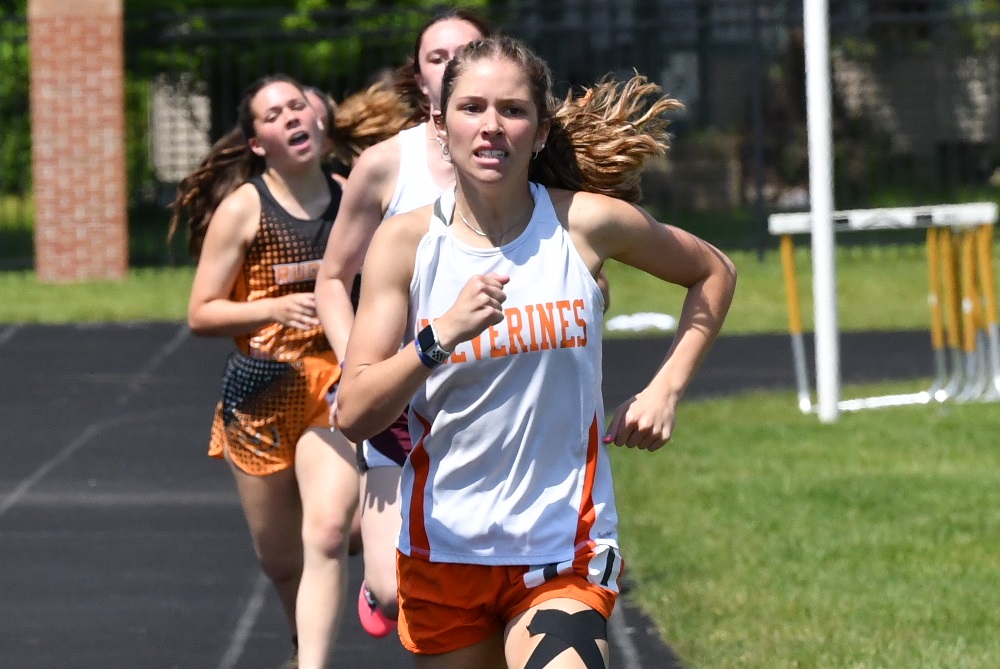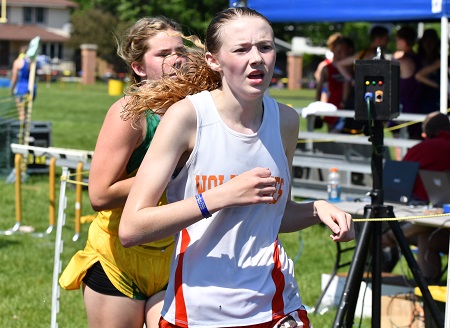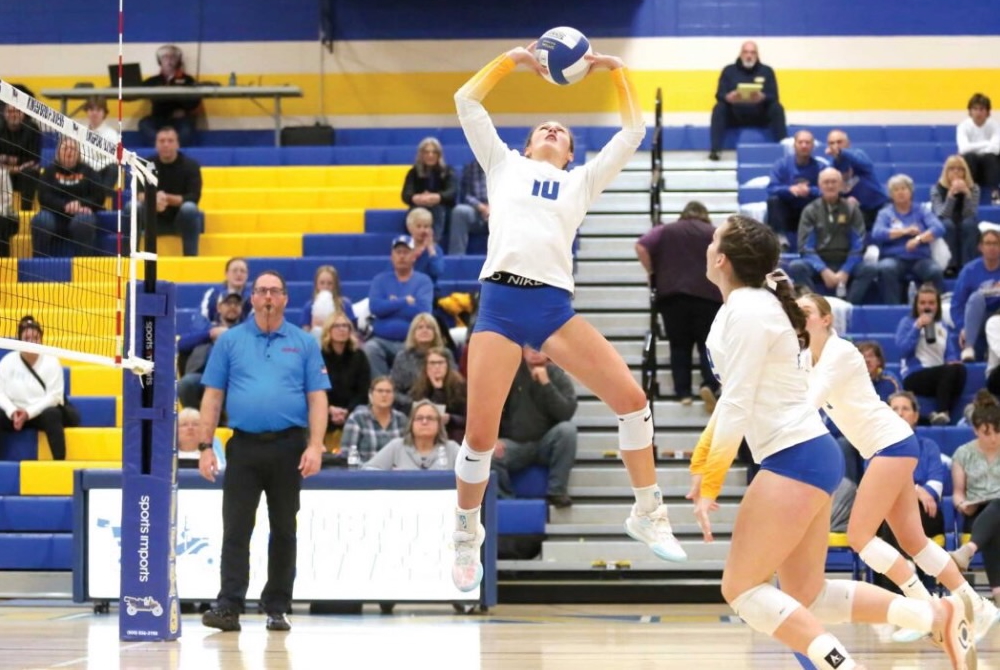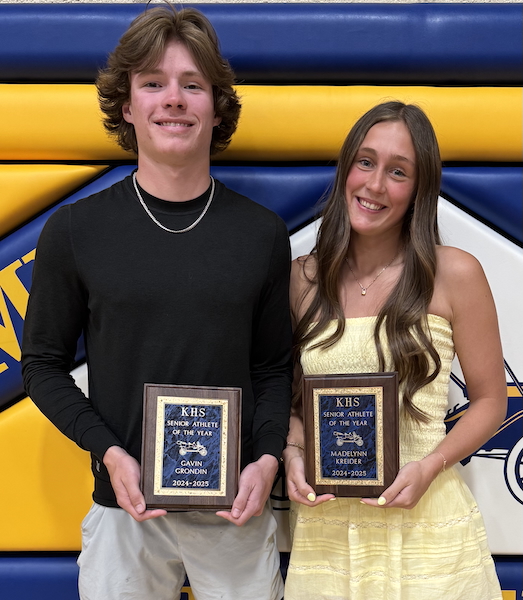
Mid Peninsula Pair Push Each Other to More Finals Success
By
John Vrancic
Special for MHSAA.com
June 22, 2021
ST. NICHOLAS — Daisy Englund and Landry Koski have been training partners for the past six years.
 Things will be different this fall, however, as Englund begins her collegiate running career at Ferris State University and Koski enters her senior year at Rock Mid Peninsula High School.
Things will be different this fall, however, as Englund begins her collegiate running career at Ferris State University and Koski enters her senior year at Rock Mid Peninsula High School.
“It’s definitely going to be different without Daisy here,” said Koski. “It’s definitely going to be a change, and it was really a big change without (2020 grads) Kennedy (Englund) and Chevy (Koski). Although, it’s a good feeling to have the team. That just makes everything better. It helps you mentally because it’s nice to have friends to experience that with you.”
Englund was in seventh grade when she and Koski became teammates.
“I ran cross country in sixth grade,” said Englund. “My seventh grade year is when we started running together. We pushed each other and made each other better, and Chevy and Kennedy weren’t all that far behind us. I didn’t start out the best, but when I got into eighth grade I was on varsity and my times improved.”
Koski also recalls what the early days were like.
“I just loved running,” she said. “In my first year of cross country the races were only 1½ miles, but it was hard to stay with Kennedy. I didn’t know how to pace myself, then I kind of learned as I went on. I didn’t know what I was capable of doing.”
Both have come a long way, which was evident during the Upper Peninsula Division 3 Finals on June 5 at Kingsford.
Englund was crowned 800-meter champion for the first time in two minutes, 30.75 seconds, but had won other races at the Finals.
“You only get to experience the U.P. Finals a few times in your life, and I think it makes you hard-working,” she said. “It felt great to finally get the 800 title. I honestly didn’t think I’d get it. The Ontonagon girl (sophomore Makennah Uotila) was a lot taller than me.
 “It didn’t feel like those were my last high school races, and it still doesn’t feel that way. It’s so stressful. You know what kind of ability you have, but it can be disappointing if you don’t perform the way you want.”
“It didn’t feel like those were my last high school races, and it still doesn’t feel that way. It’s so stressful. You know what kind of ability you have, but it can be disappointing if you don’t perform the way you want.”
Koski was seeded eighth going into the 1,600, but came from behind to win it in a season-best 5:39.89 on a very hot and humid day.
“It always gets so nerve-wracking in the end,” said Koski. “You don’t know what everybody else has left. In my freshman year I won the 1,600 and 3,200. I didn’t think I’d win those because Danika Walters (of Superior Central) was real good. You never know what’s going to happen. At the Finals, you see so many schools you don’t see during the regular season, especially this year without having the (Superior) Dome meets.”
Englund was crowned UPD3 cross country champion in 2018 and 2020, with Koski gaining top honors in 2019.
“It was always our goal to get Mid Pen’s name out there,” said Englund. “I always liked running against the bigger schools.”
“Many people think ‘you’re just Division 3,’” Koski added. “It makes you want to go out there and prove yourself.”
Englund was awaiting a training schedule from Ferris State as she prepares for her first collegiate season.
“It’s going to be different,” she said. “I’m not going to have Landry down there. I’ve been running by myself, although we’ll probably be running together this summer. August 22 is moving-in day and practices start in late August. It will be more intense training. We’ll probably run about 15-20 miles a week.”
 John Vrancic has covered high school sports in the Upper Peninsula since joining the Escanaba Daily Press staff in 1985. He is known most prominently across the peninsula for his extensive coverage of cross country and track & field that frequently appears in newspapers from the Wisconsin border to Lake Huron. He received the James Trethewey Award for Distinguished Service in 2015 from the Upper Peninsula Sportswriters and Sportscasters Association.
John Vrancic has covered high school sports in the Upper Peninsula since joining the Escanaba Daily Press staff in 1985. He is known most prominently across the peninsula for his extensive coverage of cross country and track & field that frequently appears in newspapers from the Wisconsin border to Lake Huron. He received the James Trethewey Award for Distinguished Service in 2015 from the Upper Peninsula Sportswriters and Sportscasters Association.
PHOTOS: (Top) Rock Mid Peninsula’s Daisy Englund leads the 800 on the way to winning the race during the Upper Peninsula Division 3 Finals on June 5 at Kingsford High School. (Middle) Teammate Landry Koski races one of her three individual events during the championship meet. (Photos by Cara Kamps.)

Kingsford's Kreider Prepared for Next Level After Finishing Stellar Flivvers Career
By
John Vrancic
Special for MHSAA.com
June 19, 2025
KINGSFORD — After completing a successful high school volleyball career, Maddy Kreider is ready to take the next step.
 The Kingsford senior is taking her talents to Michigan Tech, where she’s expected to continue primarily as a setter.
The Kingsford senior is taking her talents to Michigan Tech, where she’s expected to continue primarily as a setter.
“That will be a big step for sure, but it’ll be exciting being with the girls,” she said. “The girls are taller in college. It will definitely be an adjustment, physically and mentally. We’ll be traveling longer distances, and it’ll be a matter of improving the mental part of my game.”
Kreider was selected the Upper Peninsula’s Defensive Player of the Year her final two seasons after the U.P. Sportswriters and Sportscasters Association began voting for all-U.P. volleyball.
“That’s quite an accomplishment,” she said. “It’s a real honor playing with girls I grew up with. We had a great season.”
The 5-foot-8 setter was a four-year starter and two-year team captain at Kingsford, leading the Flivvers to three Division 2 District titles and back-to-back undefeated Great Northern Conference championships. She twice was named GNC Player of the Year.
She was also selected all-state first team in the fall and all-state second team in 2023, and all-region throughout her prep career. Her serving percentage also topped .900 throughout her four seasons on varsity.
 Last fall, the Flivvers reached the Regional Semifinal at Manistique where they dropped a 3-2 decision to Kingsley.
Last fall, the Flivvers reached the Regional Semifinal at Manistique where they dropped a 3-2 decision to Kingsley.
“I thought we’d get through,” Kreider said. “We came out lights out in the first two sets, then it was close in the last three.”
Also among the team’s highlights this past fall was a victory at Calumet, approximately 2½ weeks after dropping a 3-1 decision to the Copper Kings on Kingsford’s home floor.
“We wanted to play them,” Kreider said. “They’re a great bunch of girls to play against. They’ve been the measuring stick up here for many years. Winning on their floor was super exciting. We knew we had to play well just to be competitive. That was a great confidence builder for our group. We were definitely on a high going into the District.”
The Flivvers opened their postseason with a 3-1 triumph over Houghton, then defeated Escanaba in straight sets in the District Final.
Kreider will join Calumet senior Maddie Torola at MTU this fall. Torola, who recorded a season-high 19 kills in the four-set victory at Kingsford, helped the Copper Kings finish 29-5 and reach the Division 3 Regional Final at Sault Ste. Marie where they dropped a 3-2 decision to Traverse City St. Francis.
“It was fun playing against her in high school,” Kreider said. “It will be even more fun playing as teammates. It’ll be exciting to be playing on the same team.”
Both will be playing under new head coach Cindy Pindral at Tech. Both of Kreider’s parents played for the Huskies, her mother (and Kingsford varsity coach) Jaclynn volleyball from 1998-2002 and her father Jason basketball from 1997-2000.
Maddy Kreider recently earned an additional honor when she was selected Female Athlete of the Year for Kingsford’s Class of 2025. She recently completed a solid track & field season for the Flivvers.
At the U.P. Division 1 Finals, Kreider placed fourth in the 100-meter dash (13.2) and anchored the Flivvers to a third-place finish in the 800 relay (1:51.57) and fourth in the 400 (53.03) on their home track.
Kreider was named one of 32 MHSAA/Farm Bureau Insurance Scholar-Athlete Award winners this winter and plans to study exercise science and kinesiology at MTU.
 John Vrancic has covered high school sports in the Upper Peninsula since joining the Escanaba Daily Press staff in 1985. He is known most prominently across the peninsula for his extensive coverage of cross country and track & field that frequently appears in newspapers from the Wisconsin border to Lake Huron. He received the James Trethewey Award for Distinguished Service in 2015 from the Upper Peninsula Sportswriters and Sportscasters Association.
John Vrancic has covered high school sports in the Upper Peninsula since joining the Escanaba Daily Press staff in 1985. He is known most prominently across the peninsula for his extensive coverage of cross country and track & field that frequently appears in newspapers from the Wisconsin border to Lake Huron. He received the James Trethewey Award for Distinguished Service in 2015 from the Upper Peninsula Sportswriters and Sportscasters Association.
PHOTOS (Top) Kingsford’s Maddy Kreider sets for her teammates during a match last season. (Middle) Kreider, right, takes a photo with Kingsford’s Male Athlete of the Year Gavin Grondin. (Photos provided by the Kingsford athletic department.)

